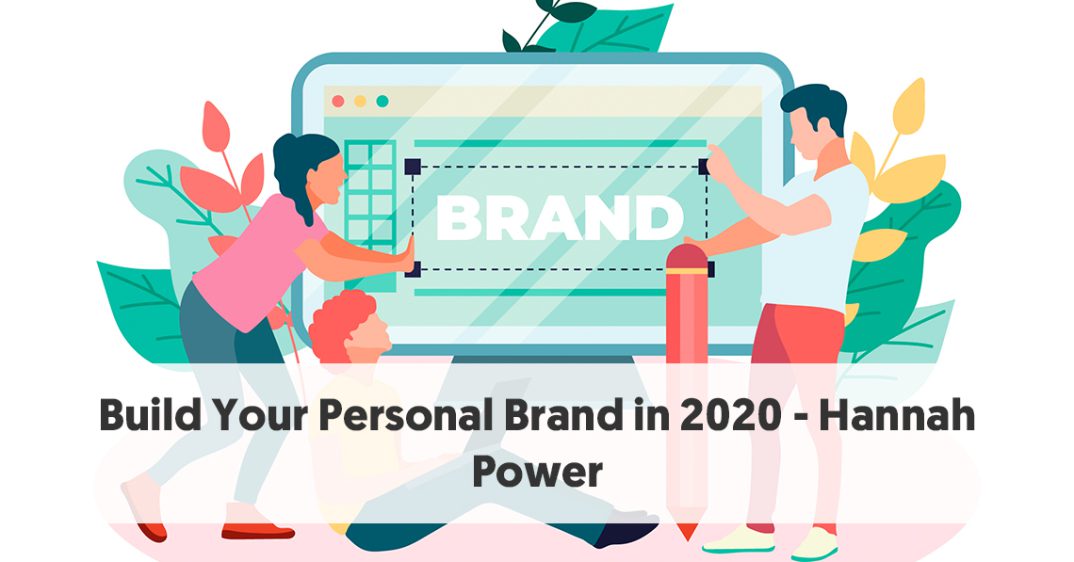As the world begins to pivot online, catalysed by the recent global pandemic, having a strong personal brand and a presence online is more important than ever. Whether we like it or not, everyone has a personal brand; if you’re reading this article, it’s likely that you have a profile on at least two social media platforms and you might even have your own website. That right there, is your personal brand. In an increasingly digital age, having a strong personal brand is becoming vital if you are to succeed in the online space; TikTok, YouTube and Instagram influencers have demonstrated the speed at which a personal brand can be built and have impact. But as we navigate our way through 2020, we are noticing a shift towards consumers’ desire for authenticity and honesty. People are desperate for change; they aren’t interested in the filtered, edited version of you. They want the real, open and honest you.
How to Build Your Personal Brand in 2020:
So, here’s my five steps which will guide you through how to build your personal brand in 2020:
Start with a Purpose
The first step in building your personal brand and to be honest, with any project at all, is to gain clarity as to what your mission, vision, and goals are. In today’s world, people follow those who inspire them, the people who believe what they believe. Because of the ever-changing landscape of business in this modern world we live in, it’s highly important that you understand and communicate exactly who you are, who you serve, and what you can bring to the table.
Identify your WHY, which, in Simon Sinek’s words, is who you truly are and not who you aspire to be.
Don’t start your personal brand just for the sake of doing it. Brands that remain superficial, that don’t share their vulnerabilities or their truth rarely create a real bond with those who follow them.
In order for you to really uncover your true purpose and values, it’s important to have a clear understanding of what moves you and what moves your followers.
So remember: step 1 is to start with a clear and authentic purpose.
Define a clear niche
Imagine being at a party, with people you haven’t met before. When meeting new people, do you know exactly how to introduce yourself in a way that enables the other person to understand, with clarity, who you are and what you do? Or do you struggle with it?
With a clear, defined niche, you are guaranteed to be able to communicate effectively who you are, who you serve, and what you do.
So how exactly do you identify your niche? I’ve broken the process down into 5 simple points:
What you love
Building a personal brand should come from a place of love. It shouldn’t be borne out of something that’s trendy or shiny. Your personal brand is ideally something that you love, something you enjoy, something that sparks your passion.

What you’re best at
Think of that one thing your friends or family members always come to you to ask help for. What’s that something that makes you feel alive and in flow whenever you’re doing it? What do you always get compliments about? What do your friends say about you when you’re not there?
Knowing what you’re best at is crucial in building a strong brand. This is how to serve others, this is how to help solve people’s problems… by doing the thing you’re best.
Below you’ll see four quadrants that you can fill out with your soft and hard skills – this will help you identify your strengths.

What makes you unique
Having a clear idea of what sets you apart from the rest (well, the competition) enables you to position yourself better and cement your authority in your industry.
Remember that we now live in the digital world, and we’re being bombarded with information from the moment we log on to our news feeds. Aim to grab attention, to be interesting, to deliver value. We’ve been told that our attention span has shortened, but personally, I don’t believe that to be true. We see people sitting through episodes of Netflix shows, so there’s definitely some attention there. What this teaches us is that the quality of your content matters, the value of your message matters.
Your experience and qualifications
Without a doubt, having something to show for supersedes any press release or promotion. When you have clarity it builds your self-confidence; credibility develops others’ confidence in you. Always aim to deliver and amplify your achievements. It’s not about being cocky; it’s about celebrating your wins and successes with those who genuinely root for you!
Write all your accomplishments down and take a look at how these could tie into what your niche is.
Your one “thing”
Now it’s time for you really narrow down and hyperfocus on your ONE THING. Most of the time, we want to be everything for everyone… we want to do everything at once and often get distracted by all the “shiny” things.
As early as now, draw a line in the sand. Be very specific with what you can do, what you can’t, who you serve, who you don’t, what you care about, and what you can’t put time and effort into. Do this and your niche will unveil itself to you.

Create to Serve
If I ask you now who your ideal customer is… would you be able to describe him or her to me with precision and clarity? Can you answer these questions?
- What’s her/his name?
- What’s their job?
- Which part of town do they live?
What do they do during their free time?
Building a personal brand in 2020 requires a lot of attention and focus on who your target audience is. This allows you to serve them better, by knowing what their specific needs and pain points are.
Creating to serve is an element in your personal branding that allows you to understand that all of your efforts should be about the people who need your services, your product, your expertise.
The Internet has allowed end users to take more of the centre stage when it comes to creating and designing new things. Personal branding is no exception. Turn your focus toward your audience and away from yourself.
Communicate Clearly
“The human brain, no matter what region of the world it comes from, is drawn toward clarity and away from confusion” – Donald Miller
Did you know that the human attention span online is now just eight seconds? To put that into perspective, Goldfish have an attention span of nine seconds. Quite worrying, isn’t it, that we can’t focus our attention for longer than a goldfish?
Essentially, this means that you have fewer than seven seconds to grab someone’s attention and get across as much as you can about what you do and whom you serve as quickly and as clearly as possible.
Now that you understand your customer, who they are and what their pains are, you can communicate with them effectively. This enables you to attract your ideal customer and filter out the ones you don’t want in under seven seconds
When I work with my clients, I take them through five steps to create different communication statements: Your core message, your tagline, your slogan, your statement and your story. Once you’ve written these you will have enough clear communication to go on every social media site, every website, every speaker bio. Think of them as a toolkit of messages:
Your core message
First, you need to start by creating your core message. This is something you might use to introduce yourself at a networking event or at the start of the speech and is designed to accurately portray everything you need it to in one sentence. Your core message should go something like this:
- I (verb) (dream customer)
- To…(product/service/value you give)
- So that…(the tangible outcome/happy ending)
Your tagline
Your tagline is a shorter, more impactful version of your core message. It’s the kind of thing you’ll use on a social media bio or the front page of your website. Start with your core message and play around with it until its punchier. Aim for around five to seven words; it should be short, sharp and to the point.
Your slogan
A slogan is a short and striking or memorable phrase used in advertising. It’s even shorter than a tagline, often just a few words. Slogans rarely say much about what the company does but should be motivational and memorable; take Nike’s slogan for example, ‘just do it’.
Your statement
The fourth communication statement is a little longer, offering more information. An empathy statement is something you may use in a longer bio, for example on LinedIn or to introduce a sales brochure. The aim of this is to position yourself as someone who understands their customer’s pain and has a solution to it. It needs to include:
- Your customers problem
- Your solution
- A tangible outcome or ‘happy ending’
Your story
The final communication statement you’ll need is your story. Don’t panic, you’re actually going to use a lot of the information you’ve already written. This is where you’ll see the true value of the toolkit you’ve created. Your story needs to include:
- I believe…
- My mission…
- Customer problem…
- My solution…
- Credibility…
- Happy ending (tangible outcome people get from working with you/consuming your content)
Your goal with these communication statements is to have created the clearest, catchiest sentences you possibly can to engage your target audience.
Create authentic content
One of the biggest personal branding trends we’re seeing in 2020 is authenticity, honesty and openness. With the internet growing at an exponential rate, there is a wealth of information available. But, it’s somewhat lacking when it comes to authenticity; it’s hardly surprising that a recent survey reported that only 18% of consumers say they trust business leaders to be truthful. That’s why it’s so important that your content is real and genuine.
So much of the content we see is overly curated and seemingly ‘perfect’; there’s so many apps and tools we can use to edit our content and disguise our true selves behind filters, photoshop and posing for hours to get the right photo. People want change, they are desperate for authentic content and realness.
Authenticity is being vulnerable, having values, and being true to them. You can leverage this to build trust with your target audience and become known as an expert in your niche as the real, authentic you.
Here are some ways to create authentic content that resonates with your audience:
1. Tell your story and showcase your voice. As we touched upon earlier…ask yourself, what is the ‘why’ behind your brand? Tell your audience this through engaging and authentic content. Be real and be honest.
2. Use video content. Many of you will find this a scary thing to do…and so did I when I first started creating video content. But don’t let the fear of what others may think hold you back…it doesn’t have to be perfect, it just needs to be authentic. The modern consumer wants and expects to see video content, and video content keeps audiences engaged longer than any other form of content. This includes live-stream video too, with 80% of respondents to a LiveStream survey saying they’d rather watch live video than read a blog post. So, if you’re yet to bite the bullet and jump on the video trend, I highly recommend that you do! It’s not as scary as it sounds, I promise.

3. Post photos of yourself. Photos of people often get far more engagement than graphics. I’m by no means suggesting that you ditch your brand graphics, but make sure you’re posting a combination of the two! People want to see real people and real stories. Let your audience get to know you, develop a personal connection and build a relationship of trust.
I hope you’ve found these steps helpful and that I’ve inspired you to build your personal brand! If you’d like to find out where you’re currently at with your personal brand then I invite you to take this free personal branding quiz to find out your score and how you could improve! https://www.powerfulleaders.co/scorecard

Author Bio

Hannah Power
Hannah is a Personal Branding Specialist focused on supporting purpose driven entrepreneurs and experts to become powerful online leaders. Hannah’s passion for personal branding started in 2012 and has became her full time focus in 2018 with the creation of ‘Powerful Leaders’ which delivers Personal Branding Coaching & Training and ‘PowerStudios’, a Personal Branding Agency.
About the Author
![]()
Writer
The Influencer Marketing Hub Team brings together a diverse group of experts with a passion for influencer marketing, digital trends, and social media strategies. Each piece of content crafted by this team is researched and written to provide valuable insights, tips, and updates for our readers. Our authors are dedicated to delivering high-quality, informative, and engaging articles that help businesses and influencers thrive in this rapidly changing digital world.






